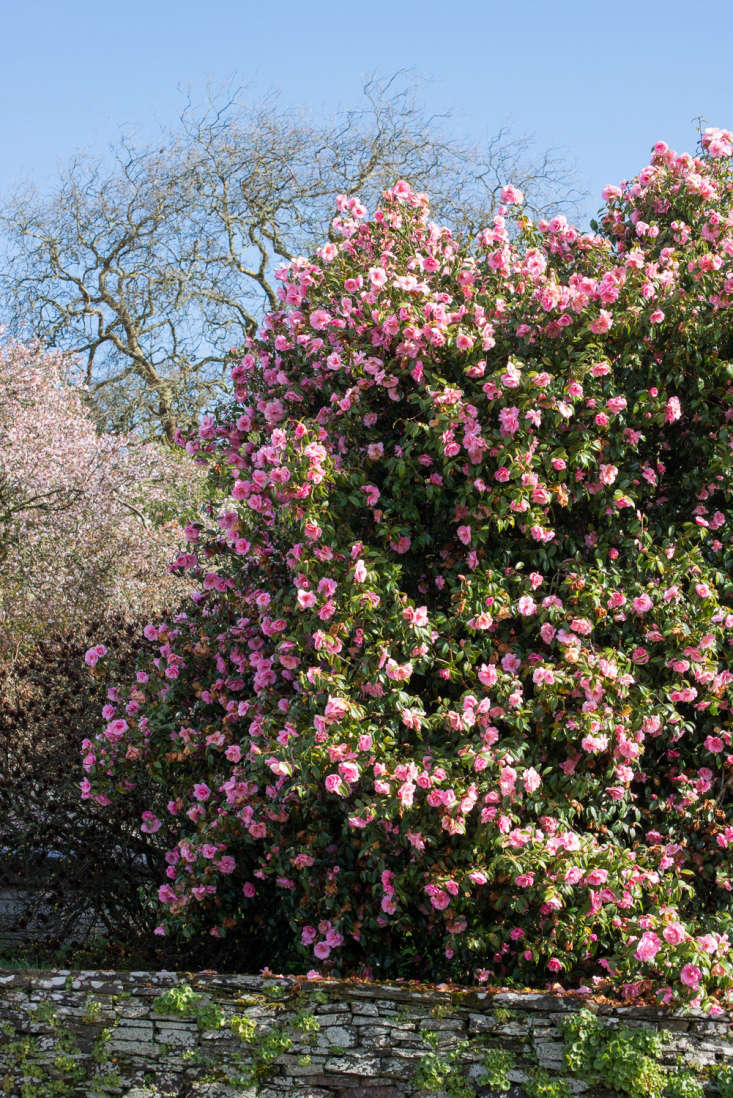An overgrown shrub, an Oakleaf hydrangea the size of an adolescent elephant, has taken over my Brooklyn backyard. It’s well over 8 feet tall, with branches stretching across almost the entire width of my 15-foot garden. To walk past it, I am forced to bend nearly double. What to do?
Shrubs that grow too big are one of the most common problems in the garden, I learned after consulting three local landscape designers—Tracey Hohman, Joan McDonald, and Nancy Crumley—who frequently are called on to confront clients’ overgrown plants. They agreed there are basically two solutions: shrub removal or pruning. Which strategy is right for you? The answer depends on whether you love your shrub, hate it, or have mixed feelings:
Are you emotionally attached to your overgrown shrub?

Designer Tracey Hohman, who lives and works in the leafy Victorian neighborhood of Ditmas Park, believes you should only keep plants in your garden if you love them or if they are serving a useful purpose such as providing privacy or masking something ugly. She has developed a succinct checklist of guidelines for clients who are trying to decide what to do about an overgrown shrub:
- If you hate it, get rid of it.
- If your feelings are mixed, experiment, cut it back and see if you can make it work.
- If you love your shrub, hire a professional to prune it.
Did you “inherit” an overgrown shrub from a previous owner?

A shrub does not enjoy protected status in a garden simply because it exists. If an overgrown shrub was planted by a previous owner, ask yourself if it fits the vision you have for your garden. Joan McDonald, owner of Gardens by Joan, says that while you may not dislike a plant you have inherited, it still might need to go. An Oakleaf hydrangea, for instance, would be totally out of place if you wanted to create a sleek refined Japanese garden design. In such a case Joan says she advises clients to remove the plant completely. For the undecided, she has this handy rhyme: “When in doubt, rip it out.”
How do you remove an overgrown shrub?

If your plant is truly huge (i.e. an Oakleaf hydrangea the size of a teenage elephant), it makes sense to hire professionals (with digging equipment) to get the job done. But if your plant is a more manageable size, there are a number of techniques you can use.
If you plan to move it to new location or give it to another gardener, you will need to dig it out with care to minimize damage to the root system. That means using hand tools such as a perennial shovel or ditch spade and digging at the edge of the root ball. Pull it out of the earth only when you have dug out or significantly loosened all of the roots.

If a shrub is on its way to the compost heap, you can be more aggressive, chopping the roots away from the main stem with a hatchet or saw and digging them up separately after you have pulled out the trunk.
Tip: Tracey Hohman offers this DIY approach for large shrubs: first, cut the plant completely down to the ground. Cover the remaining trunk or stems with a plastic tarp and leave that in place for a year. At the end of that time, remove the tarp. The roots should now be much easier to pull out of the soil.
How do you prune an overgrown shrub?

Nancy Crumley, who lives and works in Park Slope as well as in other neighborhoods, is a passionate advocate of artful pruning. She says she has seen the vigor and beauty of unhealthy, overgrown plants brought back with judicious cutting. All three garden designers I consulted recommended bringing in a professional if a plant has been neglected for a long time and its growth is out of control. However, if you want to tackle the job yourself, they offered these tips:
- Use sharp pruners.
- Avoid pruning in summer heat or in late fall.
- Always remove branches that cross or are damaged or diseased.
- Take breaks and examine your work from all sides to make sure you are working evenly and creating a pleasing shape.

All the experts advised research. For your particular plant, determine when and how to best prune it. Tracey Hohman recommends The Royal Horticultural Society Pruning and Training: What When and How to Prune ($14.81 from Amazon), which she considers the bible of pruning (and which she frequently consults on behalf of both her clients and callers to the Brooklyn Botanic Garden Hotline, where she is a weekly volunteer).

One handy pruning technique suggested by Nancy Crumley is “limbing up.” On a large shrub, remove the lower branches to give the plant a more tree-like appearance while clearing the area below and around it. This creates open space to add new plants, a major plus in a small garden where planting space is always at a premium.

Back to the issue of the giant Oakleaf hydrangea, Joan McDonald suggested considering replacing it with a smaller variety such as ‘Munchkin’, ‘Pee Wee or ‘Sike’s Dwarf”. But, she said, if I want to keep my plant (I do) the solution is renovation pruning.
What is renovation pruning?
Renovation pruning involves cutting a third of the plant’s stems down to a height of 2 feet or less. According to McDonald, this should ideally be done after the shrub has bloomed every year for three consecutive years and will eventually produce a rejuvenated, more reasonably sized shrub. (Oakleaf hydrangeas bloom on old wood, and although my plant would likely tolerate being cut completely down to the ground all at once, doing so would mean sacrificing a whole summer of flowers.) My big friend in the backyard doesn’t know it yet, but he is in for a major haircut.
N.B.: Show your shrubs you’re in charge. For more help, see:
- Shrubs 101: A Design Guide.
- English Boxwood: Is It Worth It?
- 5 Favorites: Brit-Style Garden Hedges.
- The Cult of the Wild Camellia.
Finally, get more ideas on how to plant, grow, and care for various shrubs and hedges with our Shrubs: A Field Guide.










Have a Question or Comment About This Post?
Join the conversation